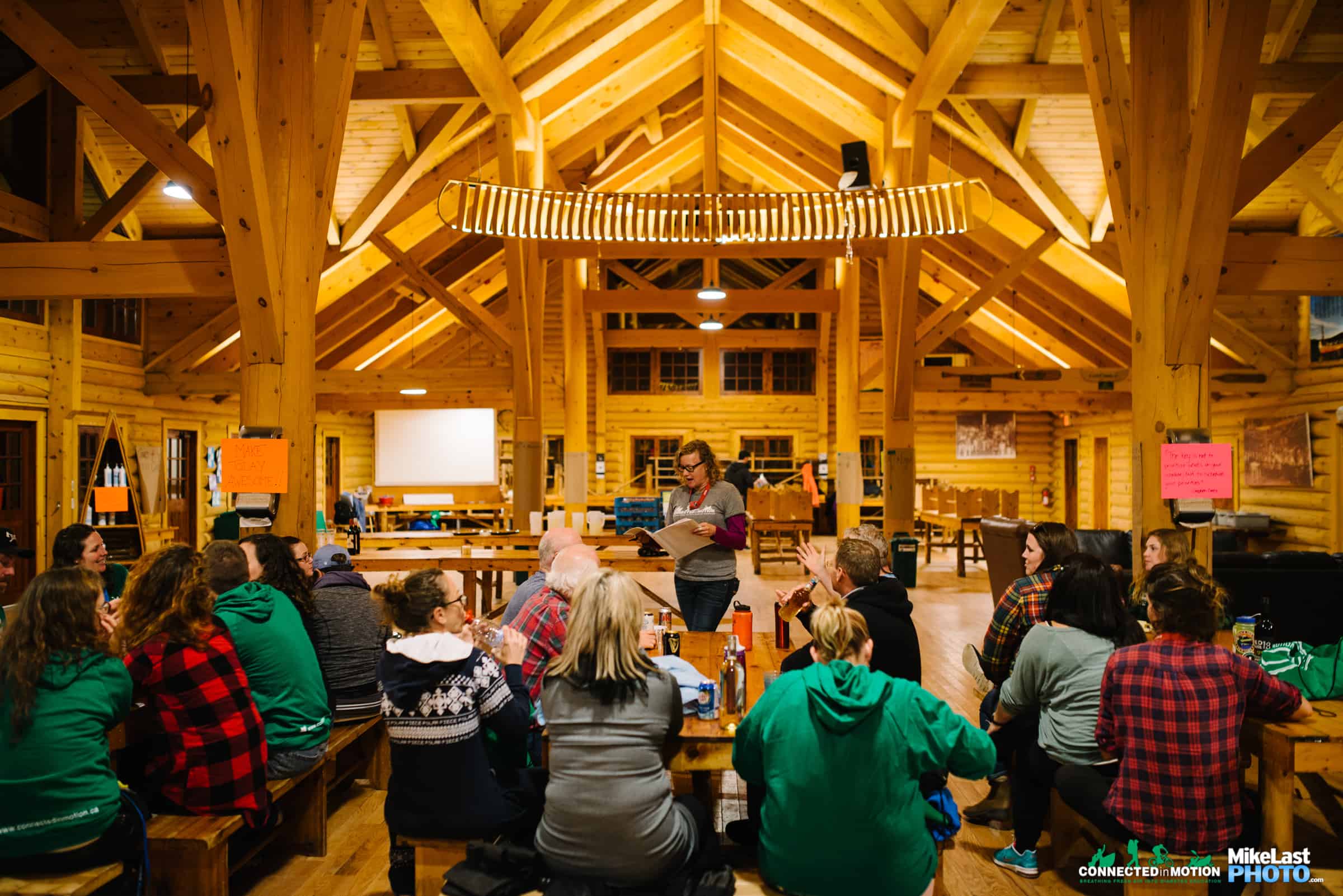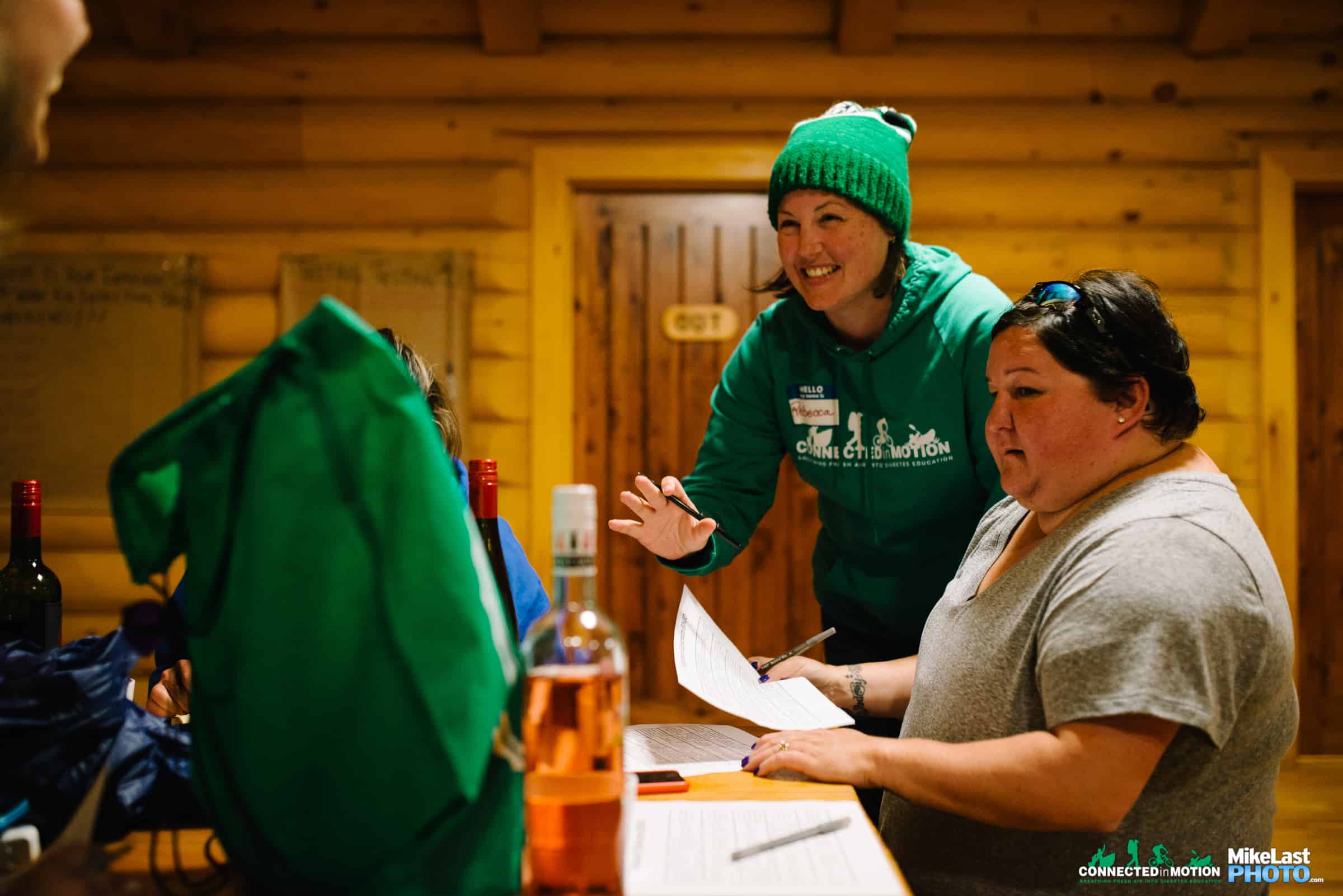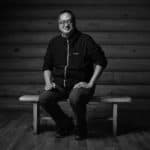CIM Note: We wanted to bring you a different perspective on our Slipstreams. In the coming weeks, we’ll be featuring a mini-series of blogs by Brad Lee. He experienced Summer Slipstream in his first ever Slipstream experience this year. His reflections, observations and letter home are all chronicled in the following posts. Catch up by reading part 1 and part 2.
The Connected in Motion gang were on the ball. A small hive of activity moved from the centre of a massive dining hall, which looked like it could easily fit the 50 or so Slipstreamers who were expected to arrive by nightfall. There was an industrial-sized kitchen through swinging doors, where a welcoming cup of hot coffee, tea or hot chocolate could be found.

I recognized Jen Hanson in the crowd, after meeting her at a summertime culinary event at a downtown Toronto cooking studio, where we learned from a professional chef how to design a tasty meal with less carbs. Jen is the very well-connected head of Connected in Motion who embodies a bolt of pure energy, and is willing to share her knowledge and experience, making Type 1 diabetes easier. She was also the key conduit to Arowhon camp staff who would be able to give me some angling intel on Tepee Lake. That’s how I briefly met Andre, who casually mentioned that he’d just pulled the two main docks from their moorings the previous day. I nodded conspiratorially, knowing that Ol’ Bucketmouth and his pals were likely still in the vicinity. I formulated a quick plan that would let me take a poke at a little bass fishing between canoeing, diabetes tech talks, cookie cook-off, high-ropes obstacle course, and campfires. Looked like I was committed to camp.
A fire was blazing in the lake-slate stone fireplace, marked with birch saplings forming an “A”, and emanating comforting warmth on a frigid, drizzly day. The lake outside was shrouded in wisps of mist, hinting at the difference between warmer water and cooler air temperatures. It was a bit of information I’d file for later use when exploring Tepee Lake’s transition zones and drop offs for big, late-season fish.

The shoreline was cluttered at both ends with the stacked dock floats, just like Andre said. Behind the trees, bright yellow canoe hulls and kayaks were visible, pulled up on shore and next to pick-up-stick piles of paddles – beavertail, Huron, and square-tails, to match paddlers’ height, skill and purpose. Camp staffers drifted between tables set up to greet Slipstreamers driving in from points all over southern Ontario and a few neighbouring U.S. states.
I lingered a long while in front of the fireplace, as other campers straggled in. A planned orientation hike and introductory paddle on Tepee Lake were put off due to the weather. Green swag bags were doled out, containing a useful collection of diabetes paraphernalia and some propaganda (actually information pamphlets from camp sponsors). I got another copy of Adam Brown’s book, apparently the most popular contemporary read on dealing with Type 1 diabetes, written by a non-professional. It explained the bushel of chia seeds in the food cache that I’d left in the car. There was a free blood-glucose meter, some fancy stickers, a portable cool pack for insulin (not needed on days like these), a camp map and a notepad. Even more useful was a gigantic bowl of free “low snacks” – Dex4 glucose tabs, fruit gummies, granola bars, and juice boxes – that had very thoughtfully been left on the registration table.
I hadn’t met any other campers yet, other than to nod a polite “hello,” while seeking out the warmth of the fire. I watched the scene unfold. It felt a little surreal. Small talk. Chit-chat. Renewing acquaintance. A few greeted old friends. The miles and hours spent driving and anticipating camp seemed to blur, my mind lurched, and I began to see the possibilities.
Until now, my diabetes had been a solo act. Even at diagnosis, I was the only one in my family who had it in three generations; and in spite of the statistics for Canadians who have, and are believed to be pre-diabetic – some 2.5 million or thereabouts – I felt truly alone.

Sixteen years ago, I reached out for help from the usual suspects. The Canadian Diabetes Association was appropriately named to encompass and to care for those of us unlucky enough to be stricken with the disease; although I’ve always hesitated to describe it as such, feeling more that it is a condition and not something from which I’d ever fully recover. When this all started, I had immediate expectations, and when they fell short, I felt betrayed. I learned more about what is discussed in some circles as a profitable disease. Why cure it? Who benefits from advocacy and public engagement, whether it’s fundraising for a cure, or raising funds to run the organization that’s ostensibly looking for a cure. I joined two support groups, moderated by well-meaning people, but learned early on to fear my prognosis, to hate myself for not doing what was then believed necessary to avoid the problems of diabetes – kidney failure, retinopathy, limb amputation, every degree of infection known to humankind, etc. Not to mention the emotional side, and the ongoing battle against diabetic depression. For fuck’s sake, I felt like I might run out of time to deal with the rest of my life. I developed a social antipathy towards those who would size me up by my disease. I would be quick on the draw, and I would judge them first! My gut response in any conversation about my diabetes would escalate quickly to mutually offensive commentary. I didn’t care. Screw them.
Except that I knew deep inside that I didn’t really want to go through life that way. So when the first Slipstreamer I met at dinner asked innocently, “So how long have you had diabetes?” I had to check my response.
“Sixteen years,” I exhaled. “Adult late onset is what they called it. I didn’t know why then, and I still don’t know why now.”
I felt the weight from years of self-imposed solitary confinement fade away. And I felt free for the first time in a long while.
Turns out my newfound pal, Marcel, a father of two kids, was also at camp for the first time, and totally on his own. Both of us had been living with Type I for about he same number of years. Trust was strange and immediate. There was no need to be defensive, mentally or otherwise, and the conversation flowed. I learned about and, literally, heard new continuous glucose monitoring devices that Slipstreamers wore on their arms, or under their shirts. This was new technology that was revolutionizing diabetic self-care, and monitored care for children, giving audible warnings of trending lows and highs. I felt like a caveman when I tested my blood sugars by pricking a finger and drawing a droplet of blood onto a disposable test strip.

It was odd to see people celebrating being together because of Type 1 diabetes. I heard snippets of other conversations at other tables about a grueling hike on the North Coast Trail of Vancouver Island, and another earlier trek to Gros Morne National Park, in Newfoundland. There was mention of two annual canoe trips in the summer – one exclusively for T1D paddlers, and another with “5.5ers,” a tongue-in-cheek reference to our non-diabetic support partners whose blood sugars are always in perfect range. I learned about technology updates that improved diabetes care. I didn’t really know what was happening, but it felt beyond good. And I liked it.
In a Google search about Camp Arowhon, I’d read that its founders were strong believers in active, experiential learning that was reinforced by positive behaviour in all aspects of life at camp. Camp director Joanne Kates, a fellow journalist who worked as food critic at the Globe and Mail newspaper, wrote in a 2006 blog post that she’d developed a “social safety toolkit” for anyone who experienced Arowhon. The focus, she wrote, was “safety on the inside.”
Kates said she measured success when campers would say: “People accept you for who you are here.”
About Brad Lee
 Brad Lee is a recovering journalist and avid fly angler who’s as happy chasing fish, in rivers or by Hobie kayak, as he is introducing others to the sport. Sixteen years on, he’s still learning to live well with Type 1 diabetes. He enjoys sharing good food with friends, cooking, travelling and exploring Ontario and the world.
Brad Lee is a recovering journalist and avid fly angler who’s as happy chasing fish, in rivers or by Hobie kayak, as he is introducing others to the sport. Sixteen years on, he’s still learning to live well with Type 1 diabetes. He enjoys sharing good food with friends, cooking, travelling and exploring Ontario and the world.




